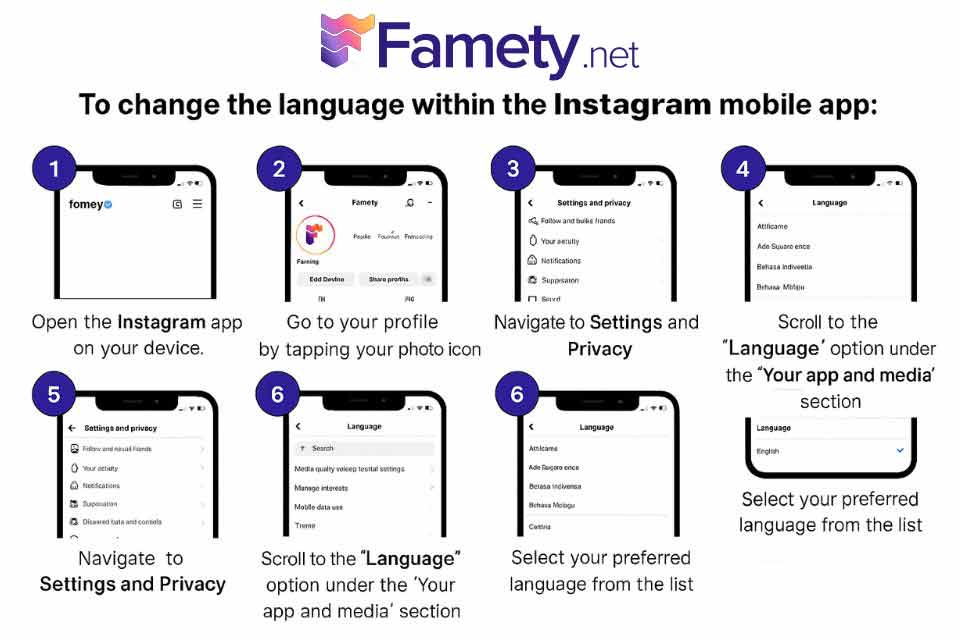- Changing Instagram’s language customizes the app interface without translating user-generated content.
- Access language settings in the app via Profile → Menu → Settings and Privacy → Your App and Media → Language.
- Selected language applies after app refresh or restart.
- App language can override device language unless automatic sync is active.
- Instagram stores language preferences at the account level, syncing across devices.
- Meta ecosystem integration can cause language changes to sync with Facebook/Messenger unless decoupled.
- Fallbacks occur to English or device language during errors, updates, or restrictions.
- On Android, change language directly in Instagram settings without affecting system language.
- On iOS, change language via iPhone Settings → Instagram → Language, which ties to system-level settings.
- Restarting the app or device can fix inconsistencies after a language change.
Changing the language on Instagram is a direct way to align your app experience with your personal or professional needs. Whether for comfort, efficiency, or brand alignment, adjusting the interface language affects not only visual elements but also how content is curated and displayed across the platform.
To change the language within the Instagram mobile app:
- Open the Instagram app on your device.
- Go to your profile by tapping your photo icon.
- Tap the three lines (menu) in the top-right corner.
- Navigate to Settings and Privacy.
- Scroll to the “Language” option under the “Your app and media” section.
- Select your preferred language from the list.
The app will automatically restart or refresh to apply your selection. Language preferences update the interface text, labels, and navigation prompts but do not translate user-generated content or captions.
This process does not affect your system language unless Instagram is synced with your device’s default settings. In those cases, the change may require additional steps in system settings or may revert if automatic sync is active. Also, don’t forget that you can get Instagram channel members if you are ready to reach a global audience!
Understanding how to manually change your language ensures consistent control over your digital environment, especially when switching between accounts, managing international audiences, or using Instagram across devices with varying default languages.
Understanding Instagram’s Language Settings Structure
Instagram’s language preferences operate through a layered structure, where app-level settings and system-level defaults can either work together or conflict. Recognizing this hierarchy is essential for maintaining consistent control, particularly in multilingual environments or on shared devices.
App Language vs. Device Language
Instagram allows users to manually select a language within the app, which overrides the device’s system language. However, if no explicit preference is set, the app defaults to the device language. This fallback mechanism is especially common during fresh installations or after cache resets.
Meta Ecosystem Synchronization
Because Instagram is part of the broader Meta platform, settings may align across linked services like Facebook or Messenger especially if single sign-on (SSO) is used. In some cases, changing the language on Facebook can indirectly trigger a shift on Instagram unless manually decoupled.
Language Persistence by Account, Not Device
Language preferences are typically stored at the account level, not strictly per device. When logging into the same account across multiple devices, the chosen language often syncs automatically. This is useful for creators, marketers, or business users who alternate between mobile and desktop.
Default Fallbacks and Reversion Triggers
When errors occur such as update failures, version mismatches, or regional restrictions Instagram may revert to English or the device’s default language. This can appear random to the user but is governed by system logic designed to ensure accessibility even under disruption.
By understanding this structure, users can more effectively anticipate changes, troubleshoot inconsistencies, and configure their accounts to better reflect their language preferences in both isolated and integrated Meta environments.

Step-by-Step: Change Instagram Language on Android and iOS
Changing the language on Instagram is a localized action that works slightly differently depending on your operating system. Below is a precise guide for both Android and iOS users to update the interface language without affecting other apps.
For Android Users:
- Open the Instagram app on your Android device.
- Tap your profile icon at the bottom right.
- Tap the three-line menu in the upper right corner.
- Select “Settings and privacy.”
- Scroll to the “Your app and media” section.
- Tap “Language.”
- Choose your desired language from the list.
- The app will refresh with the new interface language.
Android allows Instagram to operate independently of the device’s system language. This means you can run Instagram in one language and the rest of the device in another, provided app-level permissions are correctly set.
For iOS Users:
- Open the Settings app on your iPhone.
- Scroll down and tap “Instagram.”
- Tap “Language.”
- Select the preferred language.
- iOS may prompt you to restart the app or return to home screen.
- Open Instagram again to see the new language applied.
Unlike Android, iOS links app language preferences directly to the device’s system-level settings. Any changes made here may also affect iOS-wide language behaviors, depending on your system version and region settings.
Optional Reset
If you experience inconsistencies after changing the language, logging out and back in or restarting your device often resolves cached interface glitches.
Summary by Editor: Scheduling Instagram posts boosts consistency and engagement without manual effort. Using Meta’s Creator Studio or other tools...
Summary by Editor: On Instagram, “flagging” is another term for reporting a post or user. The flag icon under posts is actually a save feat...
By following these instructions, users can quickly localize Instagram without reinstalling the app or modifying other settings. This is particularly valuable for multilingual users, international travelers, and social media managers who operate in diverse linguistic markets.







